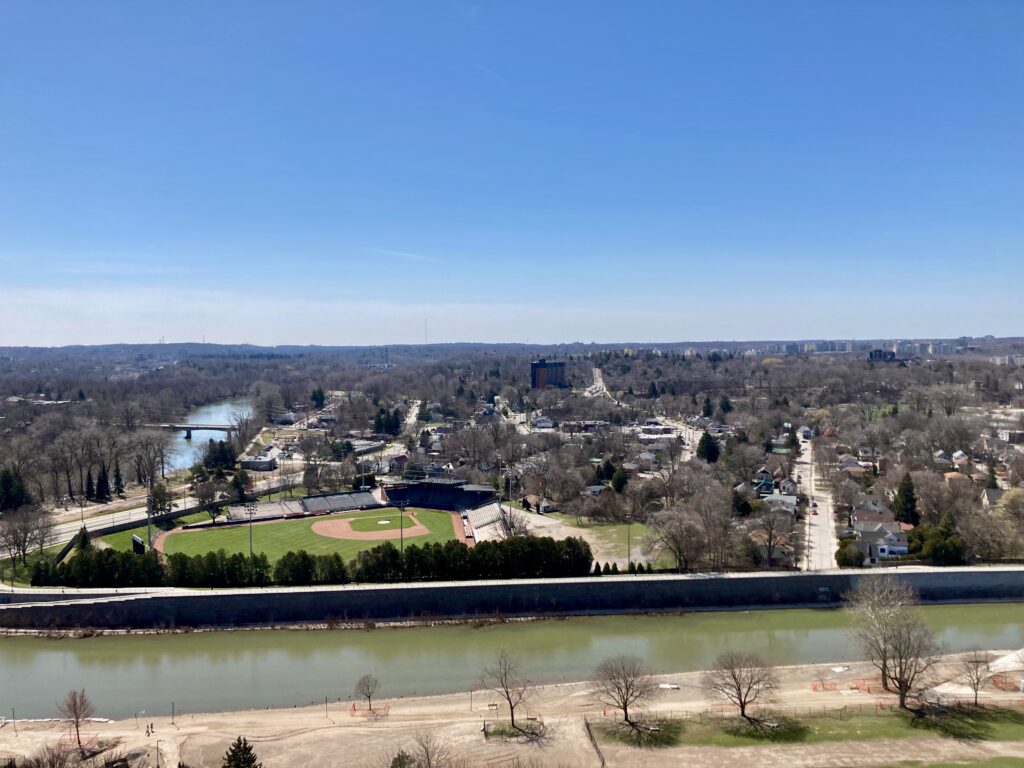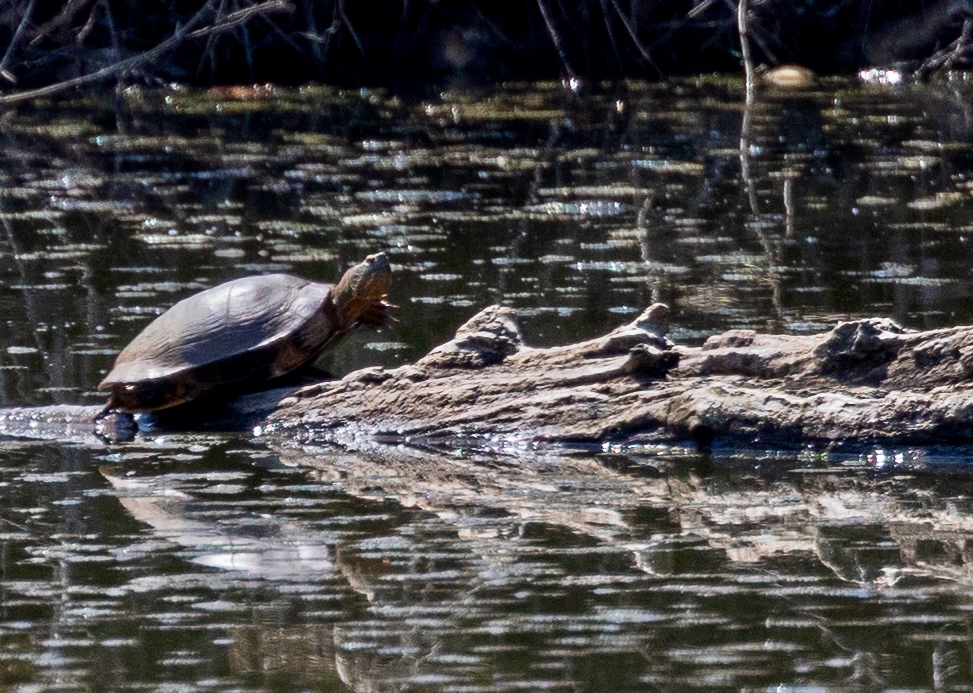Our weather continues to be erratic. Sunday, April 13 was sunny and warm with Centigrade temperatures in the mid to high teens. Tuesday, the temperature dropped to 2C but is predicted to be 22C on Friday before it falls to more normal temperatures in the teens after that. At least the sun was shining on Thursday. Friday and Saturday were warm, but overcast and rainy. The grass at the stadium is green. The trees are stillmbare with few signs of buds.

The Coves – April 13
According to the Upper Thames River Conservation Authority, “The Coves Environmentally Significant Area (ESA) is centred on a former oxbow of the Thames River. An oxbow is a U-shaped body of water that forms when a river’s meander is cut off, creating an isolated pond or marsh. This former meander is now three separate ponds, as parts of the old channel have filled with sediment. The ESA also contains marshes, ravines, woodlands, and meadows.”


We first walked along the main pond where there were a few Canada Geese, Mallards and a lone Pied-billed Grebe. Turtles basked on logs on the far side of the pond. It was hard to identify these, but they were likely Red-eared Sliders, released pets that have become invasive. There was pond scum – floating masses of algae – on the pond that indicates degraded water quality that needs to be addressed.


The birds were singing, but stayed mostly out of sight or high up in the trees. We identified 17 species, including this Carolina Wren.


We walked a trail through a wooded area that was still flooded. In this pond, a few Mallards were foraging watched over by a Canada Goose perched on a stump.


A pair of Wood Ducks cruised along in another flooded area. What a wonderful sight!



There were patches of flowers in bloom, all introduced species that have naturalized in the ESA: Scilla, Sweet Violets (purple and white) and Bird-in-a-Bush.







We came across Cellophane Bees again and caught them on some of the blossoms.



Alumni Stadium
Here are a few photos that were missed in last week’s post. In addition to the plump American Robin and handsome Mallard drake, is a photo of the Osprey on the nest box at the stadium awaiting its mate.




Osprey News
“Our” Ospreys continue to puzzle us and defy expectations. Usually, the male of a pair arrives at the nest site prior to the female. Our female has arrived before her current partner both years they have been together. This year, she arrived on March 27th and he followed on March 30th. Although some Osprey websites indicate that a three-week period of courtship follows the reunion of the pair, we have witnessed few of the courtship behaviours described. These include the pair spending time on the nest together, the male bringing food to the female and performing aerial displays before mating. Our pair did spent time on the nest together, initially far apart and then more closely for a few days around April 3rd and 4th. After that, we most often saw the female standing on the nest and the male perched on the low platform. We did not see any deliveries of fish to the female, but our observation time has been limited by the weather conditions. Most often, we saw one of the pair feeding on the low platform, sometimes with the second standing nearby. In one photo, it appears to be the female consuming the fish while the male stands by.
Recently, from about April 13th, we have seen the female sitting low in the nest through all kinds of weather. This indicates to us that she is likely sitting on an egg. We clearly have missed any mating that took place! Some accounts indicate that eggs are laid one to three days after copulation. The female lays between one and four eggs one to three days apart. The eggs hatch in the order they were laid after an incubation period of 34 to 40 days. While the female is usually the one to incubate the eggs, we recently witnessed the male sitting low in the nest when the female returned. He then lifted off, only to circle back and land on the female’s back. This is the first time we’ve seen copulation (captured in the video below) this year.
Now that the weather has allowed us to leave the balcony door open and video life on the nest more frequently, we have witnessed the female another unexpected role for the female. While she was on the nest, an intruder flew low over the nest. The female rose up to fend off the intruder. Shortly afterward, the male arrived on the nest and both male and female mantled their wings to protect the nest as the intruder returned. It was then the female that took flight to chase the intruder away. See the action in the second part of this video.
Two screen shots from the video (45 seconds from the start) show are from the first approach of the unwelcome visitor. The female was alone on the nest and lifted up to repel the intruder (above her) before it could land. Most of the second attack action is off-screen and I have no good clips. That time, the male was covering their eggs while she left the nest and started flying at the intruder.
Again on Saturday, the female sent up an alarm call from the nest when another Osprey approached. The male was perched on the low platform and mantled his wings over the platform. As the intruder swooped low over the platform, the male rose up to repel it. The male then flew to the nest and mantled while the female took flight and chased the intruder until it flew a good distance beyond the stadium and the river. This female is a force to be reckoned with!


Flower Farm News
Saturday was the first day of the outdoor market at Covent Garden Market in downtown London. The Wandering Bee was there with tulips to brighten the day. The flower season has begun!



1964
This was the name of one of the many Beatles tribute bands. It was the year The Beatles came to America, appeared on The Ed Sullivan Show, and released A Hard Day’s Night. But there were other musicians that year. Here is my playlist.
